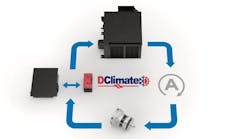Electrification impressions: EVs meeting DHL's expectations
With a totally decarbonized commercial vehicle industry inching closer each day, how and when fleets adapt to the operational, infrastructure, and maintenance needs of EVs is a topic that can't be avoided. Luckily, there are many trailblazers currently integrating zero-emission vehicles into their fleets that can share their insights on the benefits and limitations of EVs, advice for the future, and important elements to consider before investing in them. Here is DHL's story so far:
EVs account for a quarter of DHL’s global fleet of 119,000 assets, so the company is well on its way to meeting its goal of net-zero emissions by 2050. Replacing one diesel truck with an EV saves an average of 100 tons of CO2e per year, according to the German-based company.
“Over the past 10 years, DHL Supply Chain has made progress with EVs across most vehicle sizes, including light duty, yard trucks, and heavy duty. Thus far, we have been satisfied with vehicle performance,” noted Stephan Schablinski, VP of operations excellence for DHL Supply Chain’s GoGreen business, which focuses on sustainable transport.
Read more: What EVs mean for fleet shop operations
Along with meeting emissions, Schablinski cited several benefits to drivers—quieter operation leading to flexible night operations, less fatigue so fewer accidents, and all that torque and acceleration provided by the electric powertrain. The maintenance department also comes out as the winners.
“EVs have longer service intervals and lower maintenance costs because they have fewer parts,” he noted. “For example, a diesel engine has approximately 200 parts that need to be maintained and replaced if and when they wear out. An electric [powertrain] has around 20 parts.”
In North America, half of the logistics company’s yard tractors are electric, though heavy-duty will be slower to reach that level until various areas catch up. Schablinski pointed out DHL is “faced with a host of uncertainties, such as lead time, supply chain issues, and other factors that will need to stabilize before organizations can scale heavy-duty EVs.”
Fleets have many more hurdles to overcome and questions to ask prior to adopting EVs. Schablinski said these include:
- “Is EV service available close to the operation?”
- “Are incentives available and are we eligible?”
- “Does the incentive timing match the implementation timeline?”
A fleet must also coordinate across multiple stakeholders, including the building landlord, utility and facility managers, charging hardware and software providers, as well as installers.
“It’s also important to consider that everything needs to happen within a specific and thoughtful timeline,” he advised. “We don’t want the truck to arrive a year before the EV charging infrastructure or the other way around, as the clock on depreciation and OEM warranty starts ticking at the time of delivery.”
All these challenges are to be expected during such a massive technology transformation, though, and the potential is worth the effort, he reasoned.
“Considering what current EV technology can deliver, the time it takes to implement, and the cost, EVs are meeting our expectations,” Schablinski said. “As the technology and overall EV ecosystem evolve in the future, there is a significant opportunity to simplify, standardize, and work through some teething issues that come with any new and innovative technology.”
After seeing how those 30,000 EVs work in fleet operations, Schablinski has noted some room for improvement.
“EV charger cords are limited in length—typically 19 ft. with some up to 25 ft.,” he said. “Therefore, it is important for OEMs to align on a standard placement for the truck charging ports. If one OEM places it under the driver door and another places it farther back, this can lead to a problem, as you are not able to reach the port to charge the truck.”
His suggestion?
“It would be ideal to have different charge port options on the front, driver door, passenger door, and back,” he said. “These small adjustments and customizations would make a big difference in terms of ease of use.”





